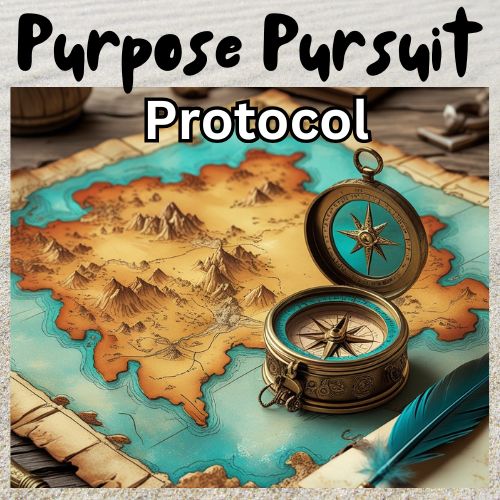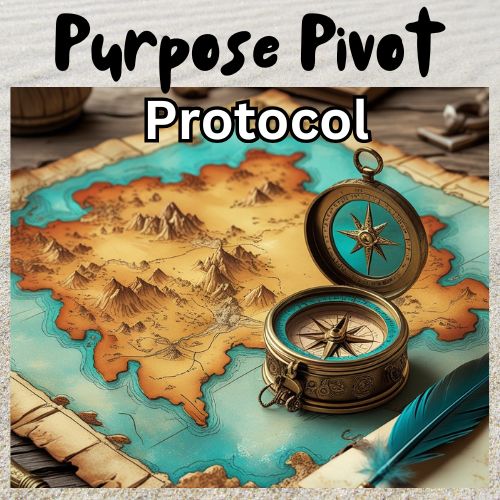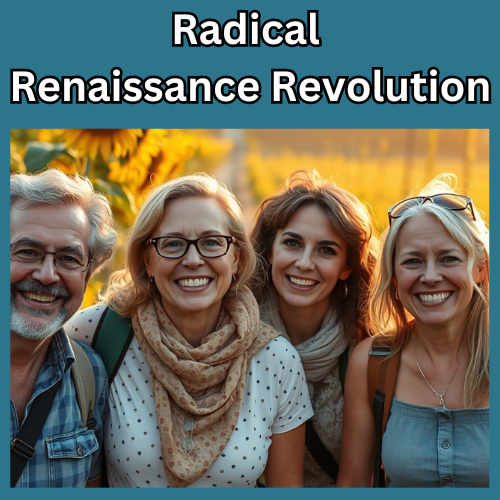All you need is love – John Lennon
Summary
This article explores the profound difference between being needed for what you do versus being loved for who you are. Through the story of Sophie Lemaire, we uncover how many people mistake feeling useful for being loved, leading to burnout, resentment, and a hollow sense of self-worth. We’ll examine why understanding this distinction is crucial for authentic relationships and personal fulfilment, and how discovering your life purpose can transform your relationship with both yourself and others.
5 Key Takeaways
- Being needed creates dependency; being loved creates connection – One is transactional, the other transformational
- Your worth isn’t your work – You are valuable simply by existing, not by what you produce or provide
- Authentic love sees you, not just your usefulness, and appreciates your essence, quirks, and humanity
- Purpose clarity helps distinguish between roles and identity – Knowing why you’re here prevents you from being just what you do
- Setting boundaries protects your relationships – Saying no to being constantly needed opens space for being genuinely loved
Picture this: You’re scrolling through your phone at 11 PM, and there it is—another text asking for a favour. Your heart sinks. Not because you don’t want to help, but because somewhere deep down, you wonder if people would still reach out just to say hello if you couldn’t solve their problems, babysit their kids, or work late to finish before their deadline.
If this sounds familiar, you’re not alone. You’re caught in what I call “The Needed vs Loved Dilemma”—that sneaky little belief that being needed equals being loved. But here’s the truth bomb that might sting a little: being someone’s go-to person for everything doesn’t mean you’re their go-to person for love.
Invisible but Indispensable Sophie
At forty-two, Sophie Lemaire had perfected the art of being useful.
Each day began not with coffee but with the vibration of her phone slitting the silence. Texts flashing like distress signals. Calendar alerts stacked like dominoes. Her brother’s name flashing on the screen—“Do you think Mom should try those new meds? She didn’t sleep a wink last night.” At the same time, her VP at work fires off a Slack message with three flaming emojis and: “Sophie, that deck. Need it by EOD! 🔥🔥🔥”
She responded to both messages before her feet hit the floor.
People often said she was indispensable—a word they spoke like a compliment, though it had long started to feel like a kind of sentence. Sophie was the axis upon which three worlds spun: a high-octane career in marketing, the slow, sorrowful orbit of her mother’s decline, and the unspoken family role of “fixer,” a position she’d accepted so long ago she couldn’t even remember applying.
Her days were a blur of other peoople’s needs—she could write a campaign pitch with one hand while sorting her mother’s prescriptions with the other, all while gently talking her friend Maria down from another cliffside heartbreak. Sophie had become expert at patching the cracks in other people’s lives while her own foundation quietly eroded beneath her.
Still, there was a kind of high to being needed that softened the loneliness.
“I felt important,” she confessed to me once. She twisted the ring on her finger, not looking up. “I thought that meant I was loved.”
Her birthday fell on a Tuesday that year.
She stayed late at the office, polishing a deck for a colleague who’d “totally owe her one.” She skipped lunch. She left with a headache. At home, the apartment was silent but for the hum of her mother’s oxygen machine.
Dinner was scrambled eggs, because that’s all her mother could chew without choking. After cleaning up, she curled onto the couch with her phone, only to be ambushed by another call from Maria—another hour-and-a-half marathon counselling her best friend through another dating disaster.
By the time Sophie hung up, it was 10:06 PM. Her phone’s battery was at 3%. Her spirit, even lower.
She stared at the blank ceiling above her. A single thought pressed through the haze.
No one remembered her birthday.
“I am surrounded by people who need me,” she whispered into the dark, almost to herself. “But I feel completely alone.”
“I felt so important,” Sophie told me during one of our coaching sessions, her voice loaded with a mixture of exhaustion and confusion. “Everyone needed me. I thought that meant I was loved.”
Sophie’s story isn’t unique.
The Anatomy of Being Needed vs. Being Loved
Let’s dissect this distinction, shall we? Because understanding the difference isn’t just philosophical—it’s life-changing.
Being Needed: The Relationship Resume
When you’re needed, you’re valued for your:
- Skills and abilities
- Availability and reliability
- Problem-solving capacity
- What you can provide or produce
- Your usefulness in specific situations
Think of it as being someone’s human Swiss Army knife. Very handy, but ultimately replaceable when they find a better tool.
Being Loved: The Relationship Revolution
When you’re loved, you’re cherished for your:
- Unique personality and quirks
- Presence, not just your presents
- Authentic self, including your flaws
- Intrinsic worth as a human being
- The joy you bring simply by existing
Meeting Others’ Needs
When we mistake being needed for being loved, we pay a hefty price:
1. The Exhaustion Tax
Constantly being “on call” for everyone’s needs is like running a 24/7 emergency service. Sophie discovered this when she calculated that she spent less than two hours a week doing something just for herself. “I was running on empty and calling it purpose,” she laughed ruefully.
2. The Identity Crisis
When your worth becomes tied to your utility, who are you when you’re not needed? This question terrified Sophie when she considered taking a vacation. “What if they realise they don’t actually need me?” she worried. This fear reveals how being needed can become an addiction—a hit of temporary validation that requires increasingly higher doses.
3. The Resentment Build-Up
Here’s what nobody talks about: being constantly needed breeds resentment. You start keeping score. “I helped them move, planned their wedding, listened to their problems for hours, and they can’t even remember my birthday?” Sound familiar?
4. The Authenticity Deficit
When you’re always in helper mode, when do you get to be human? When do you get to have bad days, need support, or just exist without producing value? As psychologist Dr. Kristin Neff notes, “With self-compassion, we give ourselves the same kindness and care we’d give to a good friend.”
The Purpose Connection: Why Knowing Your ‘Why’ Changes Everything
This is where understanding your life purpose becomes absolutely crucial. When you’re clear on why you’re here—your unique contribution to the world—you can distinguish between your calling and other people’s convenience.
Sophie’s transformation began when she enrolled in the Purpose Pursuit Protocol. Through deep reflection and guided exercises, she discovered her true purpose: helping others find their authentic voice in professional settings. This wasn’t about being needed for every little task; it was about making a specific, meaningful impact.
“Once I knew my purpose,” Sophie explained, “I could see the difference between someone needing my specific gifts and someone just needing a helping hand to solve their problems.”
Purpose as Your Compass
Your life purpose acts like a GPS for your relationships and commitments:
- It helps you say yes to what aligns with your calling
- It gives you permission to say no to what doesn’t
- It attracts people who value your unique contribution
- It transforms you from a people-pleaser to a purpose-pursuer
As Viktor Frankl wrote in “Man’s Search for Meaning,” “Those who have a ‘why’ to live, can bear with almost any ‘how.'” But I’d add this: those who know their ‘why’ can also discern who genuinely appreciates their ‘who.’
The Transition from Needed to Loved
Making this shift isn’t about becoming selfish or unhelpful. It’s about becoming selective and intentional. Here’s how:
1. The Audit Exercise
Sophie started by listing everyone who contacted her in a typical week and categorising each interaction:
- Appreciation: “Thanks for being you”
- Need: “Can you help me with…”
- Connection: “How are you doing?”
The results were eye-opening. 80% of her interactions fell into the “need” category.
2. The Boundary Revolution
Setting boundaries isn’t about building walls; it’s about installing gates with you as the gatekeeper. Sophie learned to ask herself: “Is this request aligned with my purpose, or am I just being convenient?”
She started saying things like:
- “I’m not available for that, but here’s someone who might help.”
- “I care about you, but I can’t take this on right now.”
- “Let me think about it and get back to you.” (Revolutionary concept: not everything needs an immediate yes!)
3. The Vulnerability Practice
Here’s the counterintuitive part: to be loved for who you are, you have to show who you are. Sophie began sharing her struggles, dreams, and fears with close friends. Initially terrifying, but it filtered out those who were only there for what she could do.
4. The Purpose Filter
Every request now went through Sophie’s purpose filter: “Does this align with helping others find their authentic voice, or am I just being a general problem-solver?” This clarity helped her say yes to mentoring junior colleagues while saying no to organizing every office party.
Exercise: The Love vs. Need Assessment
Take a moment to reflect on your own relationships:
Part 1: The Contact Analysis
- List the last 20 people who contacted you
- Categorise each contact as: Love/Connection, Need/Request, or Mixed
- Calculate the percentages
Part 2: The Energy Audit
- Which interactions energised you?
- Which interactions drained you?
- What patterns do you notice?
Part 3: The Purpose Connection
- How do your most draining “need-based” interactions differ from your life purpose?
- Which relationships appreciate your unique gifts vs. your general helpfulness?
Exercise: The Boundary Blueprint
Week 1: The Observation Phase
- Track every request for help you receive
- Note your automatic response
- Record how you felt before and after each interaction
Week 2: The Pause Practice
- Before responding to any request, take 24 hours (unless it’s a genuine emergency)
- Ask yourself: “Does this align with my purpose or just my people-pleasing?”
- Practice saying: “Let me check my capacity and get back to you”
Week 3: The Selective Yes
- Say yes only to requests that align with your purpose or bring you genuine joy
- For everything else, offer alternatives or simply decline gracefully
- Notice how this feels and how others respond
The Ripple Effect: How This Shift Transforms Everything
Sophie’s transformation didn’t happen overnight, but the changes were profound:
In her career: Instead of being the catch-all problem solver, she became known as the go-to person for communication coaching. Her expertise was valued, not just her willingness to work late.
In her family: Her mother initially resisted Sophie’s new boundaries, but eventually their relationship deepened. “When I stopped being her fix-everything person, we started having real conversations,” Sophie noted.
In her friendships: Some relationships faded—the ones built solely on her utility. But the remaining friendships became richer and more reciprocal.
In her self-relationship: Sophie rediscovered parts of herself she’d forgotten existed. She started painting again, joined a hiking group, and—revolutionary concept—went to movies alone without feeling guilty.
The Purpose Protocols: Your Compass to Authentic Living
If Sophie’s story resonates with you, you might be wondering: “How do I discover my own purpose to create this kind of clarity?” This is exactly why I developed two specialised programs:
The Purpose Pursuit Protocol
Perfect for those who haven’t yet discovered their life purpose. This comprehensive program guides you through:
- Deep self-discovery exercises
- Values clarification processes
- Passion and talent alignment techniques
- Mission statement development
- Purpose integration strategies

The Purpose Pursuit Protocol – if you want to discover your life purpose, this course will provide you with the clarity, motivation and direction you need to manifest your next chapter – in both your personal and professional life. Get immediate access
The Purpose Pivot Protocol
Designed for those who need to recalibrate their existing life purpose. Maybe your purpose has evolved, or life circumstances have changed. This program helps you:
- Reassess your current purpose alignment
- Navigate life transitions with purpose clarity
- Integrate new insights into your existing framework
- Realign your relationships and commitments with your evolved purpose

The Purpose Pivot Protocol – drawing inspiration from the Camino de Santiago, this transformative course guides you through a proven framework to recalibrate your authentic purpose and create a meaningful and fulfilling next act. Get immediate access
Both programs include the boundary-setting tools and relationship assessment strategies that helped Sophie (and hundreds of others) transform from being chronically needed to being authentically loved.
Learning to Laugh at Our People-Pleasing Past
Let’s take a moment to appreciate the absurdity of our former selves, shall we? Sophie now jokes about her “Swiss Army knife phase,” where she genuinely believed her value as a human being was measured by how many different problems she could solve in a single day.
“I once helped someone move, baked cookies for a bake sale, wrote a recommendation letter, and provided relationship counselling—all in the same weekend,” she laughed. “I was like a one-woman crisis response team. No wonder I was exhausted!”
This humour isn’t dismissive; it’s healing. When we can laugh at our past patterns, we create space for new ones.
Moving Forward: Your Action Plan
Ready to make the shift from being needed to being loved? Here’s your roadmap:
This Week:
- Complete the Love vs. Need Assessment
- Identify one relationship where you feel more needed than loved
- Practice the “24-hour pause” before responding to requests
This Month:
- Implement the Boundary Blueprint exercises
- Start one activity that brings you joy but serves no one else’s needs
- Have one vulnerable conversation with someone you trust
This Quarter:
- Consider enrolling in either the Purpose Pursuit or Purpose Pivot Protocol
- Evaluate which relationships have deepened vs. which have faded
- Celebrate the progress you’ve made in honouring your authentic self
Frequently Asked Questions
1. Q: What if people get angry when I stop being so available?
A: This is actually valuable information. People who are genuinely invested in you as a person will respect your boundaries and want you to be happy. Those who get angry were likely more attached to your utility than your humanity. As Dr. Henry Cloud says, “Boundaries define us. They define what is me and what is not me.” Some people won’t like your boundaries precisely because they benefited from you not having them.
2. Q: How do I know if someone loves me for who I am or just needs me?
A: Pay attention to these signs: Do they check in when you can’t help them? Do they remember details about your life that have nothing to do with what you can do for them? Are they interested in your dreams, fears, and opinions? Do they offer support when you’re going through difficult times? Love-based relationships are reciprocal and see you as a whole person, not just a resource.
3. Q: Won’t I become selfish if I stop helping everyone?
A: There’s a difference between being selfish and having healthy boundaries. Selfish people don’t care about others’ wellbeing. You’re learning to help from a place of choice rather than compulsion, and to align your helping with your purpose rather than just people’s convenience. This actually makes your help more valuable and sustainable.
4. Q: What if I lose relationships when I set boundaries?
A: You might, and that’s not necessarily a bad thing. Relationships built solely on what you can provide aren’t really relationships—they’re arrangements. As Maya Angelou said, “When people show you who they are, believe them.” If someone can’t respect your boundaries, they’re showing you they value your utility more than your wellbeing.
5. Q: How do I handle the guilt when I say no to helping?
A: Guilt often comes from old beliefs about our worth being tied to our usefulness. Remember that saying no to one thing means saying yes to something else—often something more aligned with your purpose. Practice reframing: instead of “I’m being selfish,” try “I’m being intentional.” The guilt will lessen as you see the positive results of your boundaries.
Conclusion: Your Work Is Not Your Worth
Sophie’s journey from chronic people-pleaser to purpose-driven boundary-setter isn’t just one woman’s story—it’s a roadmap for anyone who has ever wondered if they matter beyond what they can provide.
The truth is, your worth was never your work. Your value was never your utility. You are not a human doing; you are a human being. And being—simply existing as your authentic, flawed, beautiful self—is enough.
When you understand this distinction, everything changes. Your relationships become richer because they’re based on genuine connection rather than convenient transaction. Your energy increases because you’re no longer constantly depleted by others’ endless needs. Your purpose becomes clearer because you’re not drowning in everyone else’s priorities.
Most importantly, you discover what it feels like to be truly seen, appreciated, and loved for the magnificent, irreplaceable person you are—not just the handy person you can be.
As Sophie puts it now: “I used to think love was spelt H-E-L-P. Now I know it’s spelt Y-O-U M-A-T-T-E-R.”
The question isn’t whether you’ll stop being helpful—it’s whether you’ll start being intentional. Will you continue to scatter your precious energy like seed on rocky ground, or will you plant it purposefully where it can truly flourish?
Your authentic self is waiting. Your purpose is calling. And somewhere out there, people who will love you for exactly who you are—likes and dislikes, boundaries, and all—are waiting to meet the real you.
The love you seek is seeking you too. But first, you have to stop hiding behind your helpfulness long enough to be found.
Ready to discover your life purpose and transform your relationships? Explore the Purpose Pursuit Protocol for those beginning their purpose journey, or the Purpose Pivot Protocol for those ready to recalibrate. Because when you know why you’re here, you’ll know who you’re meant to be—and who’s meant to love you for it.

Ready to start again, stronger than ever before? This quiz will help you find out. It is not just about measuring where you are right now; it’s about shining a light on the areas of your life that feel meaningful, as well as those that might need attention. It’s an opportunity to reflect, recalibrate, and take steps toward a life that’s not only successful but profoundly fulfilling. Take The Quiz

“I am an experienced medical doctor – MBChB, MRCGP, NLP master pract cert, Transformational Life Coach (dip.) Life Story Coach (cert.) Stress Counselling (cert.) Med Hypnotherapy (dip.) and EAGALA (cert.) I may have an impressive number of letters after my name, and more than three decades of professional experience, but what qualifies me to excel at what I do is my intuitive understanding of my clients’ difficulties and my extensive personal experience of managing major life changes using strategies I developed over many years.” Dr M Montagu

